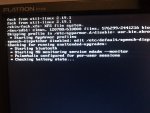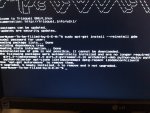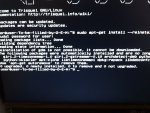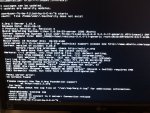install triquel will not boot into desktop
- Vous devez vous identifier ou créer un compte pour écrire des commentaires
hi my install of trisquel 64 bit as well as 32 will not boot into the desktop. it gets stuck on "checking battery state.... " how can I fix this?
hardware if that helps
Asus amd 6850
intel celeron g530
8gb ram
gygabyte motherboard ga-h61ma-d3v
tplink wireless card
I've only be using windows so bee kind as I don't know all the Linux terminology.
ops its version 5.5 the first link that's 700mbs
Welcome to GNU/Linux. Some call it just "Linux" by mistake. Have you heard about GNU?
Searching: https://duckduckgo.com/?q=ubuntu+checking+battery+state&t=trisquel
This is some problem with the display manager; if you are using GNOME (default Trisquel configuration), it is the GDM; if KDE (on Triskel edition or after installing it), KDM.
GNOME is a GNU project: https://gnu.org/software/gnome/ ; KDE is not. Neither belongs to Linux, which is a kernel and not an operating system, as GNU is.
You probably should reinstall your Display Manager:
$ sudo apt-get install --reinstall gdm
OR
$ sudo apt-get install --reinstall kdm
. There is a similar command "aptitude reinstall", though I have no clue about the differences between them, if there is any.
Welcome to Trisquel :-)
If you hit Ctrl+Alt+F1, do you get the virtual console 1?
Ebobing
Welcome to Trisquel GNU/LINUX.
About your wireless card:
You should have no isues, getting your wireless working.
TP LINK ARE FRIENDLY drivers,sort of speak.
They do support and come with their own set of linux drivers on a CD. I know this because, I'm building a desktop server from scratch using UDUTU GNU/LINUX, and both wireless PCI card, and the two Ethernet card are manufactured by TP LINK and they all do function nicely.
I'm just a newbie to GNU/LINUX.
Good luck and don't hesitate to post any questions.
Careful,
As far as I know and based on my experience with TP-LINK the company doesn't do anything special in relation to GNU/Linux. They are taking drivers/firmware developed by Atheros, Realtek, Ralink, and whoever else's chipset they might be using. TP-LINK is a brand and not one focused on GNU/Linux let alone free software so the fact something works is largely coincidence. TP-LINK might be a better choice than Linksys/Cisco/Netgear for one reason or another (maybe TP-LINK is more careful about documenting the “Linux” support on the box). However this said a lot of companies document “Linux” on the box and then do an even poorer job than companies who don't. I'll give you an example. HP documents very thoroughly the companies support for Linux. They even indicate through various wording what hardware will work with free software distributions. They don't list ANY documentation on "Linux" though on the box. Compare this to Samsung and other companies. These companies tend to list “Linux” on the box or list “Redhat” or something similar. When users actually go to use the product though they find the proprietary drivers don't work. There may or may not be some hack somewhere.. but the point is they didn't release proper (free) drivers and thus support is never going to be ideal. There is a much greater chance of losing it entirely (discontinued product, etc).
Long story short: You need to investigate the chipset first and foremost. There is various documentation on the web. This is the first thing to do before buying any hardware. And double checking the accuracy of the information (wherever possible) is highly recommended. H-node.com will list compatibility information although the accuracy of the info is a problem. I'm not a big fan of h-node or any similar system though due to the prevalence of bad info. Having to purchase products a few times is undesirable. Particularly for those less informed/less involved with GNU/Linux or free software. The problem is mainly that the chipsets used in a particular card change. What is advertised on the box as TP-LINK TL-WN781 for example might have any number of different chipsets. Maybe one of them is free software friendly and works great while another is not. There are often a dozen variations of a model. Sometimes all the models are using chipsets that are free software friendly. However that isn't always the case. It also leads to other problems. For instance people state it works with Trisquel 4 (LTS release) although that was only true for one version of the card. So the next person to buy one of these cards end sup having to purchase multiple cards before they find one that works. This is what leads to 99% of ThinkPenguins business. Cutting corners doesn't save money. It takes a lot of time and energy getting things just right and even then there are problems with the perfect solution. This is why working together so to speak and focusing resources helps improve the hardware support situation. It provides an opportunity to narrow it down to the best possible solution rather than one that is “good enough” some of the time for some use cases.
:) Sorry for the rant. It's just what I do for a living so.. I have a lot of experience and have been doing this for a long time! Even before starting ThinkPenguin I noticed there was a major problem here. I noticed the issues probably around 2005 doing testing for a commercial distribution that was trying to do basically the same think h-node and every other distributor has/did at one time or another (although it was not a free database, just a "Linux" or distribution compatibility database).
More documentation the better- but be weary and avoid giving bad advise. If HP's (or TP-LINK) stuff is usually good because they are actually doing something make a statement more like "much of HPs hardware is good, there is good documentation, etc". But that is really hard to tell in most cases unless you have a lot of experience (maybe you do IT and your business buys a lot of printers- and thus you can actually give good advise like this). I think there are a few people here who have pretty good idea what I'm talking about here. Unfortunately most aren't really that aware.
Another example statement: Most laser printers are good because of postscript support. This is a standard supported by GNU/Linux. However be watchful of low end laser printers as these devices are less likely to have a free driver, postscript support, or any GNU/Linux support for that matter.
thanks for the reply
its saying it can't download that package using the gdm sudo command(pressing ctr alt f1). could it be my network driver or do I need to put the install source in the computer.
it does not seem to be a virtual console 1
I've attach some photos. thanks for any reply




It is indeed a "real" terminal. What ISO did you install? If it is the NetInstall, it is perfectly normal that nothing graphical was installed. To check whether something graphical works you can fire:
$ startx
As for the Network connectivity, your Wifi chipset may not be supported by a free driver/firmware. The recommended solution (beside using an Ethernet connection) is to acquire a free software-friendly device as a replacement. This is a tricky process (it basically is impossible to surely know what chipset you are buying from the model only). The only reliable solution I am aware of is to get the device from ThinkPenguin. Moreover, by using the previous link (with "libre" in the URL), 25% of the benefits made on your purchase are donated to the Trisquel project.
> its saying it can't download that package using the gdm sudo
command(pressing
> ctr alt f1). could it be my network driver or do I need to put the
install
> source in the computer.
You probably don't have working networking yet.
Were you booting from the ISO or had you already completed and install
and were now rebooting into your new installation or what?
Being able to see things from /var/log might be interesting,
specifically /var/log/syslog and /var/log/dmesg.
>it does not seem to be a virtual console 1
Actually it is.
What's up with the funny OEM username? Did you input it? I haven't seen that before.
Is this a normal install or some virtualization hassle?
Does anything happen if you run
startx
If not, try reading some logs to see if there is some hint. Like
less /var/log/Xorg.0.log
(q quits) and
dmesg | less
those might or might not make any sense.
What kind of graphics card do you have?
lspci -nn|grep VGA
For that gdm reinstall thing you need a working network connection and to first do
sudo apt-get update
The OEM is basically the default if the system manufacturer doesn't enter anything when customizing the BIOS (assembler really, almost nobody manufactures anything these days beyond a handful of companies for any particular product type and even then there are hundreds of companies involved in the chain to any finished product). So basically HP, Dell, whoever would modify the BIOS and put in the brand here. This is a generic board that would be used by system manufacturers. The small ones will definitely leave it as is. Little bit bigger operations would put there logo in, make adjustments to various things here, etc.
I've installed the os after going through the install wizard so that was trying to get into the desktop(new install). it was trisquel 5.5 gnome desktop 700mb iso.
I did leave the Ethernet cable connected thorough motherboard not by a expansion card
In this picture the output states that
1) KMS (=kernel modesetting) is not supported
2) KMS is required
Perhaps a newer Linux-libre kernel would solve that problem, you can get one e.g. from http://jxself.org/linux-libre/
first, sudo nano /etc/apt/sources.list and add the mentioned deb line, ctrl+X to exit and yes save modified and use the same file name
wget http://linux-libre.fsfla.org/pub/linux-libre/freesh/archive-key.asc
sudo apt-key add archive-key.asc
sudo apt-get update and finally
sudo apt-get install linux-libre64
then reboot to see if all that was for nothing.
Why on earth is X trying to load fglrx? It is a proprietary driver. Have you add a configuration file for X (copying that of some user who does not care about her freedoms)?
How about this?
$ sudo apt-get autoremove $ sudo apt-get update $ sudo apt-get install --reinstall trisquel
(do that connected to the Internet)
"trisquel" is a "metapackage" for the default Trisquel desktop edition; it depends on many packages so when you (re)install it, it installs every package needed for its "edition" -- "triskel" brings the default KDE installation; "trisquel-mini", a lightweight desktop environment.
This is about the packages usually needed, for avoiding the stucking in "battery mode", which appears to be related with lacking GDM. I don't know about the KMS issue; as lembas suggested, you could install a newer linux-libre version and see what happens.
Besides the http://jxself.org/linux-libre/ repository, there's a Linux-libre PPA ("personal packaging archive") available at https://launchpad.net/~linux-libre/+archive/ppa with Ubuntu-specific versions. The instructions for using it are in the "PPA Description":
ADDING THIS PPA TO YOUR SYSTEM:
-------------------------------
sudo add-apt-repository ppa:linux-libre/ppa
INSTALLING LINUX-LIBRE:
-----------------------
sudo apt-get update
sudo apt-get install linux-libre
sudo apt-get dist-upgrade
- Vous devez vous identifier ou créer un compte pour écrire des commentaires


